NUKE NEWZ
IAEA steps up efforts for gender balance in nuclear sector
08 March 2024
The International Atomic Energy Agency's Director General Rafael Mariano Grossi has said that gender equality "is not just right - it is imperative for net zero, battling cancer, and ending global hunger".
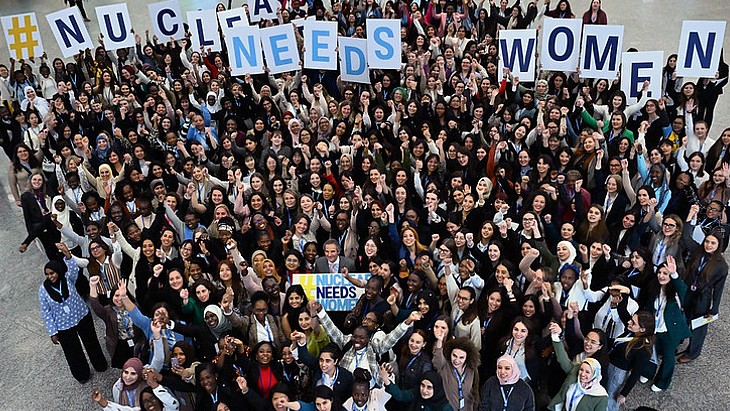 Those attending had a clear message (Image: IAEA)
Those attending had a clear message (Image: IAEA)He was speaking as more than 400 women who have taken part in the IAEA's Marie Sklodowska Curie Fellowship Programme and Lise Meitner Programme gathered at the agency's headquarters in Vienna for an event coinciding with International Women's Day. Grossi posted a message on social media calling them "trailblazers ... reshaping the nuclear field, embodying our goal to open doors & break down barriers. The world needs nuclear and #NuclearNeedsWomen".
According to the IAEA, only a fifth of the global nuclear workforce are women and it "aims to change this by attracting a new generation of women to the nuclear field and inspiring them to stay and become leaders".
The Marie Sklodowska Curie Fellowship Programme was launched in 2020 and provides scholarships to help with tuition for master's programmes and living costs and provides internship opportunities. The Lisa Meitner Programme was launched in 2023, aimed at early- and mid-career women professionals "in a multiweek visiting professional programme to advance technical and soft skills at host institutions located around the world".
During the event World Nuclear Association signed an agreement with the IAEA to jointly promote professional development opportunities for women by providing opportunities within the nuclear industry for those taking part in the two programmes.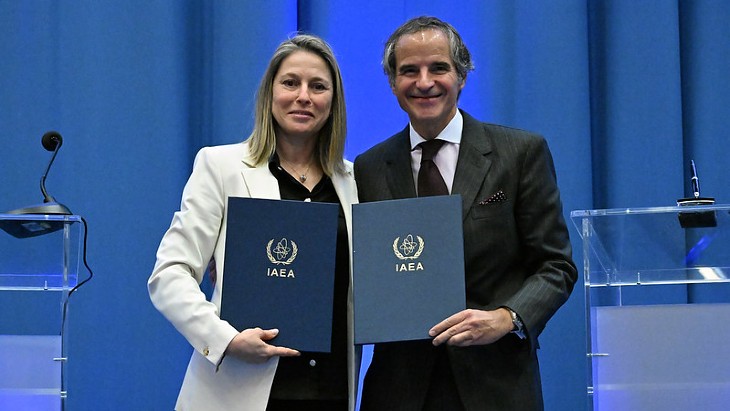
The WNA and IAEA director generals after signing the agreement (Image: IAEA)
Speaking from the event in Vienna, World Nuclear Association Director General Sama Bilbao y León said: "International Women’s Day is an opportunity to celebrate women, whilst also highlighting the ongoing challenges women face everywhere. I am thrilled to join IAEA Director General Grossi, along with dozens of other global nuclear leaders and more than four hundred Marie Sklodowska Curie and Lise Meitner fellows from all over the world, to promote increased participation of women in all aspects of the nuclear sector. We need talented women everywhere to join the nuclear industry, not just to triple global nuclear capacity, but also because including and promoting women leads to a more inclusive and empowered world."
In a joint statement issued on behalf of those attending the IAEA event, they said: "We believe it is crucial to champion and empower women in nuclear science and technology. We are convinced that encouraging women to study science and technology is one of the main drivers for progress in societies, everywhere in the world. Women constitute a global talent pool to meet the technological challenges of today, to drive economic growth and diffuse knowledge. Closing the gender gap and breaking stereotypes in STEM not only promotes fairness and equality but also maximises human potential to tackle global challenges. The world is in need of more women role models to inspire future generations of girls to rise up to the role they are expected to play in the future.
"We, participants of the IAEA Marie Sklodowska-Curie Fellowship and the Lise Meitner Programmes, pledge to support, advocate, promote and practice policies that empower women, ensure gender equality, and enable women to reach their full potential in the nuclear field ... Gender should never determine ambitions, dreams and goals. We hope girls and women around the world will keep on breaking the barriers, taking up high impact responsibilities, discovering and creating, while empowering each other."
France sets out long-term nuclear recycling plans
08 March 2024
Minister for the Economy, Finance, Industrial and Digital Sovereignty Bruno Le Maire announced the decision to continue with France's treatment-recycling strategy for used nuclear fuel beyond 2040, with plans to extend the life of existing recycling plants and to launch studies for a new MOX fuel fabrication plant and a new used fuel processing plant.
.jpg?ext=.jpg) Lescure (second from left) and Le Maire (centre) pictured with La Hague Site Director Stéphanie Gaiffe (far left) and Orano CEO Nicolas Maes (on the right) during the visit (Image: Orano)
Lescure (second from left) and Le Maire (centre) pictured with La Hague Site Director Stéphanie Gaiffe (far left) and Orano CEO Nicolas Maes (on the right) during the visit (Image: Orano)The announcement was made during a visit by Le Maire and Minister Delegate for Industry and Energy Roland Lescure to Orano's La Hague recycling site, days after France's Nuclear Policy Council (Conseil de Politique Nucléaire) said on 26 February that the country would continue with its closed nuclear fuel cycle strategy.
Le Maire announced three measures that will be taken towards this goal: a sustainability/resilience programme extending the life of the La Hague and Melox recycling plants beyond 2040; the launch of studies for a new MOX fuel fabrication plant at the La Hague site; and the launch of studies for a new used fuel processing plant, also at La Hague, by 2045-2050.
"A new page in French nuclear history is about to open. The time for large-scale national projects has returned and the nuclear energy sector has a central role to play," Le Maire said during his visit to La Hague.
In a post on X, Le Maire said the visit to La Hague by the two ministers sends a strong signal. "Thanks to this strategy, we will ultimately reduce the volume of nuclear waste by 75%," he said. "Our message is clear: nuclear power occupies a central place in the decarbonisation of our economy, the strengthening of our energy sovereignty and the reindustrialisation of our country."
Orano CEO Nicolas Maes said the announcements provide for major investments for the La Hague site. "Processing-recycling is one of the French industry's centres of excellence, representing know-how that has been mastered for some 50 years in our plants and of which all the group's employees can be proud," he said.
From the very beginning of its nuclear programme France has chosen to pursue a closed fuel cycle, reprocessing used nuclear fuel to recover uranium and plutonium for re-use. Reprocessing and recycling fuel in this way also significantly reduces the activity and volume of radioactive waste material requiring final disposal.
In the French model, the reusable materials which make up some 96% of used fuel are separated at La Hague. The plutonium recovered from this processing is reused in MOX (mixed-oxide) fuels manufactured by Orano at the Melox plant. Some 10% of nuclear electricity in France today is generated by recycling materials in the form of MOX fuel, Orano said, and this can rise to 25% and to almost 40% if used MOX fuel is further recycled.
Only the plutonium recovered from processed fuel is currently used in MOX. Reprocessed uranium - or RepU - can be re-enriched for use as fuel in existing light-water reactors. Four of France's reactors - at the Cruas-Meysse plant in Auvergne-Rhône-Alpes - are certified to use such uranium. In February, Cruas 2 became the first of those units to operate with a full core of fuel made from recycled uranium.
Reflector tank lifted for installation in Argentina's RA-10 research reactor
08 March 2024
The RA-10 reflector tank was manufactured by INVAP over 32 months at the Bariloche Atomic Centre. It is made of zirconium alloy and weighs 2540 kilograms, is 2 metres in diameter and 1.4 metres tall.
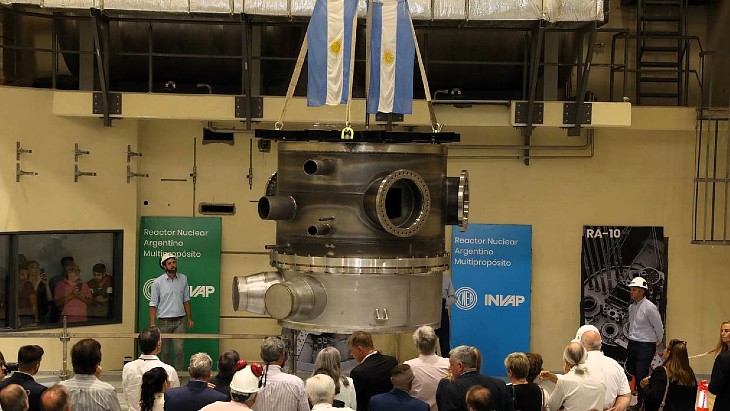 (Image: CNEA)
(Image: CNEA)It was lifted up by crane to the level of the RA-10 reactor pool ready for its installation, with the moment witnessed by visitors including Treasury Minister Carlos Guberman, together with the president of Argentina's National Atomic Energy Commission (CNEA) Adriana Serquis, staff who are working on the project and representatives of various domestic companies participating in the construction of the reactor.
RA-10 Project Manager Herman Blaumann said: "The reflector tank is a critical component ... and after its installation the stage of assembly of pool internals begins ... so we are getting closer to the start-up, which we hope can begin next year."
Once the reactor pool internals are assembled, the pool will be filled, with a target of January 2025 for pre-operational tests with the commissioning process continuing and the aim of it becoming operational in 2026.
Serquis paid tribute to the long history of nuclear expertise in Argentina, saying that knowledge, qualifications and experience had been built up over many years, adding: "That capacity that we have as a country is unique and we must not lose it."
CNEA says the RA-10 - a 30 MWt open-pool research reactor - will be used for the production of medical radioisotopes, including the capacity to cover 20% of the world demand for molybdenum: "Technetium is obtained from molybdenum, and widely used in nuclear medicine ... it will also be possible to produce other radioisotopes that are not made in the country today and that are widely used in the world, such as lutetium, which is applied to treat prostate cancer and other pathologies, as well as others for use in agriculture and the industry".
The RA-10 project was approved by the government and was officially started by CNEA in June 2010. Argentina's Nuclear Regulatory Authority granted a construction licence for RA-10 in November 2014. The civil works for the reactor began in 2016. Nuclear technology firm INVAP is involved in the design and construction of the reactor facility and related installations, playing the role of main contractor. The assembly of the RA-10 pool - which will house the core of the reactor - was completed in August 2018.
The RA-10 will replace the RA-3 reactor on the same site, a 10 MWt pool-type reactor which began operations in 1967. As well as producing radioisotopes the RA-10 will also provide new research and training opportunities and will have associated facilities such as the Argentine Neutron Beam Laboratory (LAHN) and the Laboratory for the Study of Irradiated Materials (LEMI).
Young BOOSTERS FOR nuclear groups seek rethink on Spanish nuclear closure
08 March 2024
A gathering in Madrid of more than 70 representatives from the European and international young nuclear networks, from 27 countries, heard the case put against the planned closure of Almaraz nuclear power plant's unit 1.
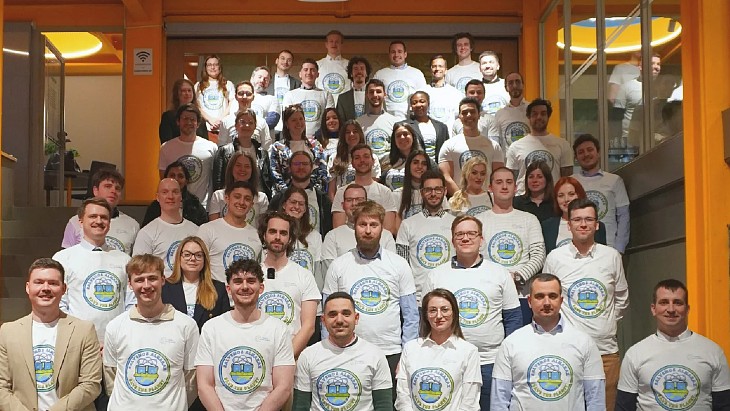 Attendees wearing Almaraz campaign t-shirts (Image: Jóvenes Nucleares)
Attendees wearing Almaraz campaign t-shirts (Image: Jóvenes Nucleares)The aim of the gathering was to share experiences of the nuclear sector in their respective countries for members of the European Nuclear Society - Young Generation Network and the International Young Nuclear Network. The host Spanish Youth Network's 'Salvemos Almaraz' ('Let's save Almaraz') initiative gained support from representatives from different countries.
Spain has seven nuclear reactors generating about a fifth of its electricity, but under its nuclear phase-out policy the fleet is scheduled to shut down by 2035, with Almaraz 1 due to be taken offline in 2027. Jóvenes Nucleares, an association for young professionals and students from the Spanish nuclear sector, noted that the two unit Almaraz nuclear power plant's 2000 MWe installed capacity generates enough electricity for 4 million homes and represents 7% of total generation in Spain, avoiding the emission of 7.2 million tonnes of CO2 per year. It also highlighted that EUR600 million (USD655 million) had been invested in maintenance and operation to be included in the highest category by World Association of Nuclear Operators.
"For all these reasons, Jóvenes Nucleares ... believes that the closure plan established in the National Integrated Energy and Climate Plan must be reconsidered. Spanish nuclear power plants generate clean energy, as they do not emit CO2, they are reliable, cheap, as proven by various studies by neutral international organisations that describe that extending the life of the plants is the most economical way to generate electricity per MW; and safe, which is not only more than demonstrated by their operation over the last 40 years, but also by their constant investment in improvements," the organisation said in a statement.
It said that 2024 was a crucial year as the deadline approaches for any reversal of the decision to end operations at Almaraz 1 in 2027. The nuclear phase-out policy was confirmed by the Spanish government in December.
The weekend also included a number of technical visits, to the TJ-II nuclear fusion device and the simulator of the control room of the Trillo nuclear power plant at Westinghouse Madrid.
Reflector tank lifted for installation in Argentina's RA-10 research reactor
08 March 2024
The RA-10 reflector tank was manufactured by INVAP over 32 months at the Bariloche Atomic Centre. It is made of zirconium alloy and weighs 2540 kilograms, is 2 metres in diameter and 1.4 metres tall.
 (Image: CNEA)
(Image: CNEA)It was lifted up by crane to the level of the RA-10 reactor pool ready for its installation, with the moment witnessed by visitors including Treasury Minister Carlos Guberman, together with the president of Argentina's National Atomic Energy Commission (CNEA) Adriana Serquis, staff who are working on the project and representatives of various domestic companies participating in the construction of the reactor.
RA-10 Project Manager Herman Blaumann said: "The reflector tank is a critical component ... and after its installation the stage of assembly of pool internals begins ... so we are getting closer to the start-up, which we hope can begin next year."
Once the reactor pool internals are assembled, the pool will be filled, with a target of January 2025 for pre-operational tests with the commissioning process continuing and the aim of it becoming operational in 2026.
Serquis paid tribute to the long history of nuclear expertise in Argentina, saying that knowledge, qualifications and experience had been built up over many years, adding: "That capacity that we have as a country is unique and we must not lose it."
CNEA says the RA-10 - a 30 MWt open-pool research reactor - will be used for the production of medical radioisotopes, including the capacity to cover 20% of the world demand for molybdenum: "Technetium is obtained from molybdenum, and widely used in nuclear medicine ... it will also be possible to produce other radioisotopes that are not made in the country today and that are widely used in the world, such as lutetium, which is applied to treat prostate cancer and other pathologies, as well as others for use in agriculture and the industry".
The RA-10 project was approved by the government and was officially started by CNEA in June 2010. Argentina's Nuclear Regulatory Authority granted a construction licence for RA-10 in November 2014. The civil works for the reactor began in 2016. Nuclear technology firm INVAP is involved in the design and construction of the reactor facility and related installations, playing the role of main contractor. The assembly of the RA-10 pool - which will house the core of the reactor - was completed in August 2018.
The RA-10 will replace the RA-3 reactor on the same site, a 10 MWt pool-type reactor which began operations in 1967. As well as producing radioisotopes the RA-10 will also provide new research and training opportunities and will have associated facilities such as the Argentine Neutron Beam Laboratory (LAHN) and the Laboratory for the Study of Irradiated Materials (LEMI).
BN-600 reactor at Beloyarsk aims for further life extension
07 March 2024
Rosenergoatom is to seek approval to extend the life of the BN-600 fast neutron reactor following an inspection of the condition of the reactor vessel, heat exchanger supports and other equipment.
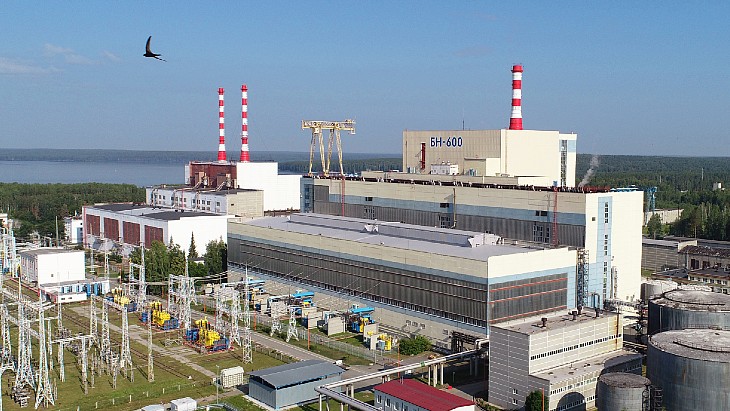 (Image: Rosenergoatom)
(Image: Rosenergoatom)Russian nuclear regulator Rostekhnadzor extended the operating licence for the fast reactor - unit 3 of the Beloyarsk nuclear power plant in the Sverdlovsk district - by a further five years in 2020. The unit began operating in 1981 and a large-scale modernisation programme had been under way from 2009 before the first extension. At the time, in 2020, Rosenergoatom said further investment work would be completed by 2024 to allow for a licence extension to 2040.
It has since completed a number of important upgrades to the safety of buildings, structures, and systems, including replacement of steam generator modules and pumping units and the aim is to submit documents to Rostekhnadzor this month, with an expectation of them being checked within a year and a decision made about a new licence.
Rosenergoatom Director General Alexander Shutikov said: "Power unit No.3 is strategically important for us. It tests technical solutions for future fast reactors - we irradiate fuel elements there both for the BREST-OD-300 reactor plant (a fast reactor with lead coolant, which is currently being built in Seversk), and for the BN-1200, which is planned to be introduced at the Beloyarsk nuclear power plant."
Director of the Beloyarsk plant, Ivan Sidorov, said that in the next two scheduled maintenance rounds "we will replace the remaining steam generator modules and feed pumps, and modernise the diesel generator sets. This work will allow us to safely and efficiently generate electricity for the residents of the Sverdlovsk region for many years".
Rosenergoatom, which is part of Rosatom, says that extending the life of the unit could allow the generation of an additional 60 billion kWh of electricity. The sodium-cooled BN-series fast reactors are part of Rosatom's Proryv, or 'Breakthrough', project to develop fast reactors with a closed fuel cycle whose mixed oxide (MOX) fuel will be reprocessed and recycled. In addition to the BN-600 reactor, the 789 MWe BN-800 fast neutron reactor - constructed as Beloyarsk unit 4 - entered commercial operation in October 2016. This is essentially a demonstration unit for fuel and design features for the larger BN-1200 being planned for the same plant.
Researched and written by World Nuclear News
No comments:
Post a Comment